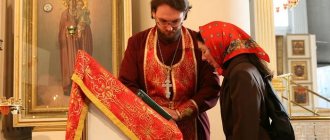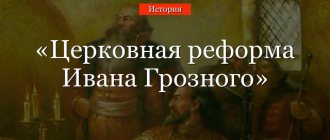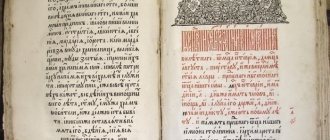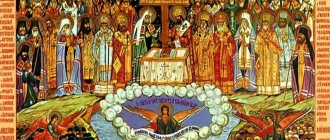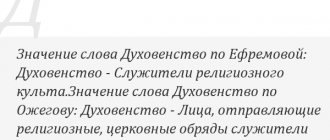The cassock is the everyday clothing of monastics and lay clergy. The cassock, regardless of cut, has wide and long sleeves with turn-ups. Lapels are usually hemmed with satin to match the fabric or in a contrasting color.
The length of the cassock reaches the floor or the heel of the shoe. Cassocks are made from wet silk or gabardine. For winter, coat fabrics are used - drape, cashmere, wool blends.
Story
The word cassock is of Greek origin and means worn out, frayed clothing, lint-free fabric. It was precisely this kind of loose-fitting clothing that was in use among the ancient Eastern peoples. During the earthly life of Jesus Christ, it was in use among the Jews, and the Lord also wore one. And in our time, the national costumes of eastern peoples include a long robe resembling a cassock.
The cassock was the obligatory clothing of the first monks; from the monastic environment it gradually entered into use among the lay priesthood.
In Rus', cassocks appeared at the end of the 17th century and gradually transformed into the current look familiar to us, and have remained so for several centuries.
Until the 17th century, the clothing of the Russian clergy were single-row caftans made of velvet and cloth in purple, crimson, and green colors. At the Great Moscow Council of 1666-1667, the clergy were recommended to wear clothing adopted by the Eastern Orthodox clergy. Gradually, robes acquired a more familiar look to us, and have remained that way for several centuries.
Why do priests wear a cassock over their clothes?
In ancient times, with the birth of Christianity, the clothing of church ministers did not differ from the everyday clothing of parishioners. Priests, bishops and deacons were identified only by appearance.
However, times have changed, and along with them, clothing fashion has also changed. The clergy, on the contrary, tried to preserve the traditions in the attire in which the first apostles and preachers were clothed, thereby differing from the believer. Gradually the differences in the appearance of the priests became more noticeable.
The cassock is an element of the wardrobe that was inherent in the wardrobe of both men and women in the East during the time of Jesus Christ. It was a floor-length cape with flared sleeves made of thick material. The cassock was worn over everyday clothes. The word “cassock” translated from Greek means “decrepit, wrinkled,” that is, clothing worn by the poor.
The cassock gained popularity among the monks of Egypt and Palestine. In 4 tbsp. her dominant color was practical black. However, among the servants this color was arbitrary, since they dyed the fabric with various mixtures, which turned it into a dirty blue cape. The cassock, bleached by the sun, usually turned red.
Types of cassocks
Depending on the cut, there are 4 types of cassocks:
- Russian;
- Greek;
- half-Russian;
- half-Greek.
The Russian cassock is set on the shoulders and has a fitted silhouette. There are two types of Russian cassock: Kiev and Moscow. The Kiev cassock is fitted only on the sides, while the Moscow cassock is fitted on the sides and back. The sleeves of the Russian cassock widen downward, the clasp is straight, butt-butted.
The Greek cassock has a loose fit, a stand-up collar, and is fastened at the collar and on the chest. The sleeves in the Greek cassock are extended from the shoulder.
Winter cassocks are insulated; coat fabrics are used to sew them. They are predominantly of the Russian type, with a shawl collar trimmed with fur or velvet.
Everyday vestments of a clergyman, cassock and cassock
The robes of clergy are visual evidence of their rank and title. They do not look like the clothes of an ordinary person, and thereby distinguish a clergyman from among the laity - even the most unchurched people can easily distinguish the priest’s attire from the ordinary everyday clothes of a modern person. This has its own meaning and history, it emphasizes that the Church is beyond the worldly, the momentary, beyond the flow of time and the demands of fashion, and for the clergy it is a constant reminder of the highest service entrusted to them by God.
The well-being and comfort of clergy largely depends on the quality and convenience of church vestments. Despite all the traditional nature of church vestments, it is impossible to completely isolate yourself from the new realities of sewing production. What requirements does church discipline impose on the appearance of a priest today? How are they implemented using modern technologies?
In this article we will focus on the everyday attire of clergy - the cassock and cassock.
The general symbolic meaning of the cassock and cassock is an internal renunciation of worldly worries and vanity, peace and tranquility of the heart, a sign of spiritual peace. The cassock and cassock are an image of the outer clothing that the Lord Jesus Christ wore during his earthly life. Thus, by wearing them, representatives of the clergy and monasticism imitate Jesus Christ according to the commandment that he gave to His disciples.
The cassock is the lower garment of a clergyman. Its color indicates which clergy - black (monastic) or white (parish priesthood) the one who wears it belongs to. The requirements for monastic priests are more stringent - their cassock can only be black. White clergy are given a relaxation in this regard, and in addition to black, they can choose dark blue, brown, gray and white attire. In modern sewing production, melange fabrics are also used for cassocks - a combination of fibers of different shades (for example, blue and white threads), which under different lighting highlights one or another tone.
The materials for making cassocks are usually cloth, wool, satin, flax, comb, and silk. Modern technologies can offer clergymen so-called “wet” silk for sewing cassocks - products made from such fabric are very soft and pleasant to the touch, resistant to wrinkles and at the same time retain the flowing texture of silk. Summer cassocks in our time are most often sewn from cotton and linen in a ratio of 80 to 20, 50 to 50, or from pure flax. In winter, wool and synthetics are quoted.
Cassocks can be decorated with embroidery along the collar or along the sides. At the same time, for the ornament, threads are taken to match the cassock, which gives it discreet beauty, or contrasting colors, which makes the cassock brighter and more elegant.
Cassock (Greek “to roson” - torn, worn out, lint-free clothing) is the outer garment of monks and clergy of all degrees with long, below the palms, wide sleeves, mostly black (for monastics). For white clergy, in addition to black, dark blue, gray, brown, cream and white are possible. As a rule, the cassock is fastened at the collar and at the belt.
The materials for cassocks are the same as for cassocks, moreover, both of them can be lined.
All services, except the Liturgy, must be performed by the priest in a cassock and cassock. In addition, at different moments of different services, other liturgical vestments (robes) are worn over them, the use of each of which is determined by the Charter. When serving the Liturgy and in other cases when the priest must be in full liturgical vestments, the cassock is removed and the so-called cassock and other vestments are put on over the cassock.
Features of the cut. Nowadays in Russia, priests wear two main styles of cassocks and cassocks: Russian and Greek. This is allowed by the church charter, but for some official events the clergy is obliged to appear in robes of Russian cut. Church discipline requires that the robes be long enough and extend to the edge of the shoes. Shoes must be black, without patterns, closed.
Russian cut
The Russian cassock and cassock come from the single-row caftan worn by our ancestors. By the way, until the 17th century, the clergy wore just such caftans, and not cassocks, but the formation of the Russian cassock occurred under the influence of the penetration of Greek robes for the clergy into our country. The caftans that the priests wore could be made from cloth of different colors: crimson, purple, green. They had narrow sleeves - in contrast to the Russian cassock that emerged later. By the way, it is known that the love of the Russian clergy for clothes of bright colors continued until the revolution itself; for example, crimson clothes were worn well.
The Russian cassock and cassock are fastened “with a wrap” (in the manner of a Russian kosovorotka) and have a fitted style. There are two variations of the Russian cassock: Kiev - fitted only on the sides and leaving the back straight, and Russian - fitted on all sides.
The sleeves of the cassock are narrow, while the sleeves of the cassock are narrow at the shoulders and greatly widen at the bottom.
Russian cut suits the harsh climate of our country: it allows you to save heat.
Greek cut
The Greek cassock and cassock came to Rus' in the 17th century, when the Great Moscow Council of 1666-1667 allowed the clergy to wear them. Both the cassock and the cassock have a stand-up collar. They are much wider than Russian ones, not fitted. The cassock has a drawstring on the back that allows you to adjust the width, and there are pockets on the chest.
The cassock is fastened only at the collar and chest. In fact, such a cassock is a transformation of an oriental robe. The sleeves of the Greek cassock are wide along the entire length. This meets the requirements of the hot southern climate, where this type of clothing was formed - Greek robes made of natural silk are especially good in this regard. Russian priests gladly wear such robes in the summer; many clergy prefer them at any time of the year, valuing freedom of movement. Such robes are also convenient for those priests whose weight constantly fluctuates.
In Greece, priests wear black cassocks and cassocks; the Russian tradition of colored robes for the clergy causes them some surprise. Cassocks with satin silk cuffs on the sleeves are common. But these lapels can also be colored - for example, purple.
Bulgarian cassock. The cassock, called Bulgarian, is a kind of hybrid of Russian and Greek cut. It has a “Greek” stand-up collar and overlapping hems, like a Russian cassock.
The choice of attire is a matter of taste and personal convenience of the clergy. The variety of modern fabrics, as well as the various advantages of a particular style, allow you to choose the option that is most comfortable for everyone.
Here is the opinion of one of our Russian priests: “I like the Russian cassock, there is something familiar in it. And Greek is a good way out in the summer heat. Some seamstresses make the mistake of not taking into account the difference between male and female figures, and the waist of the Russian cassock they sew ends up in the armpit area. Of course, this is wrong: the cassock is not a woman’s dress, and its waist should be in its place. They often sell cassocks and cassocks with unhemmed bottoms - meaning that everyone will tailor them to their height. But if necessary, you can shorten the hemmed vestment. Still, it’s more pleasant to buy clothes that you can wear right away.”
The trading and manufacturing enterprise ORTOX offers cassocks of Russian and Greek cut made of linen, cotton, gabardine, wet silk, melange, viscose, wool blend, cashmere. Colors and embroidery are available in assortment.
Products are made to order within a week. To place an order, your measurements and height are required. The bottom can be hemmed or left unhemmed according to your wishes.
How priests wore cassocks in Rus'
In Greece, the cassock retained its original oriental cut. This element did not immediately take root in Kievan Rus. The clergy were accustomed to caftans, but due to poverty, rural priests wore unpretentious caftans that were shorter than usual.
After the reform of Patriarch Nikon in the 17th century in Russia, church vestments acquired official significance. Greek attire did not take root due to its impracticality.
In the northern lands it was necessary to keep the body warm, but Greek vests did not provide warmth. Therefore, clergy used different cuts when modeling the cassock: the clothes became fitted, although the sleeves remained wide.
Such robes began to spread in the Orthodox Church in Rus' and were equated with Greek black robes.

